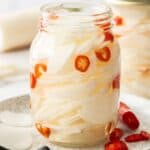
Pickled Daikon
If you enjoy crisp pickles, you will love my easy Pickled Daikon, a crunchy condiment which is an ideal accompaniment to many dishes. Its crisp texture and mild flavour is perfectly complemented by the tangy, slightly sweet pickling liquid. We use a simple technique that is incredibly easy.
Servings 1 900 ml (30 fluid oz) Jar
Calories 562kcal
Equipment
- 1 x 30 ounce/900 ml Jar
Ingredients
- 500 g (1.1 lb) daikon radish See Note 1
- 250 ml (1 cup) rice wine vinegar See Note 2
- 250 ml (1 cup) filtered water
- 110 g (½ cup) white granulated sugar - or to taste
- 3 teaspoon coarse sea salt See Note 3
- 1 long red cayenne chilli - finely sliced, optional
Instructions
To Sterilise the Jars:
- Sterilise the jar or jars you'll be using to store the pickles. Choose glass jars with an airtight, metal lid and ensure they have been washed by hand in hot soapy water then rinsed well. Check that the metal lids do not have rubber inserts – if they do, allow them to air dry, instead of placing in the oven.Preheat the oven to 130 Degrees C (270 F) and place the jars in the oven for 15-20 minutes. Keep the jars warm.
For the Pickled Daikon:
- Peel the daikon and thinly slice into rounds. Cut the rounds into halves if you prefer.
- For the pickling liquid, combine the rice wine vinegar, water, sugar and salt in a non-reactive saucepan. See Note 4.
- Bring to a simmer, stirring to dissolve the sugar. Simmer for 2 minutes.
- Add the daikon and pieces of chilli to your warm jars (I like to try and evenly disperse the chilli throughout the jar). Pour over the pickling brine.
- Seal the jar immediately, and allow to cool on the bench before placing in the refrigerator.The Pickled Daikon can be enjoyed once cool, but I recommend leaving them for 24-48 hours to allow the flavours to develop.
Notes
- Daikon radish: can be found in Asian grocery stores and through some fruit and vegetable specialists/markets. Although available year-round, like other root vegetables, they are at their best in winter. When purchasing daikon, select those that feel heavy for their size and have smooth, unblemished skin. The skin should be as white as possible, and the flesh should feel firm. Avoid those with spots, bruises, or wrinkles.
- Vinegar: I have used rice wine vinegar in this recipe (also known as just rice vinegar), however, you can also use apple cider vinegar or white vinegar.
- Coarse sea salt: ensure you use cooking salt or coarse sea salt. Regular table salt may contain anti-caking agents and is much stronger.
- Non-reactive saucepans: are those which are ceramic, stainless steel, glass or enamelled cookware. Copper, iron and aluminium pans are reactive. Acidic foods, such as lemons and vinegar, may take on a metallic taste and discolour if cooked in such pans.
- Storage: once the jars have cooled, store the pickles in the fridge for up to three weeks. This is a quick pickle recipe not designed for long term canning.
- Nutritional information: is based on the entire jar, and includes the pickling liquid.
Nutrition
Calories: 562kcal | Carbohydrates: 130g | Protein: 3g | Fat: 1g | Saturated Fat: 0.1g | Polyunsaturated Fat: 0.2g | Monounsaturated Fat: 0.1g | Sodium: 7100mg | Potassium: 1144mg | Fiber: 8g | Sugar: 122g | Calcium: 164mg | Iron: 2mg